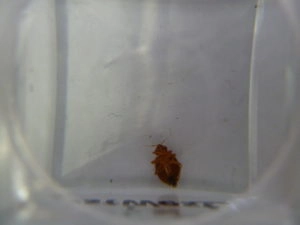Bed Bug Lookalikes and Why they Matter
In planning a course for a high school cross country team, I became keenly aware of how much the human mind gravitates toward shortcuts. This happens even when shortcuts turn out to make the process longer. We see this all too often in the pest control world and it happens quite frequently with Bed Bugs. The key place people take shortcuts is on identification. Here are the bed bug lookalikes and why they matter.
Coxae Nearly Touching
Chimney Swift Bugs

This bug looks quite similar to the common bed bug, but the key to identifying them is underneath.
I know, nobody wants to think about bed bugs even existing. Why would one want to flip it over like they are going to tickle its belly puppy style? Well, by flipping it over and observing the coxae, you can learn a lot about where it came from. As you may have guessed from the name, chimney swift bugs feed on chimney swift birds. Chimney swift birds like to hang out in chimneys. Knowing their name is key to finding the source of the population. It is also worth noting that the Chimney Swift Bug is not nocturnal like the common bed bug.
Poultry Bug
The Poultry Bug also has middle and hind coxae nearly touching at the center of its body. The differentiator between the Chimney Swift Bug and the Poultry Bug is in the beak. If the beak touches the hind coxae, it is a poultry bug.
Coxae Widely Separated
Barn Swallow Bug
If you are starting to sense a pattern in the naming, you have probably guessed that Barn Swallow Bugs feed on Barn Swallows. Even though all of these blood-sucking bugs have preferred hosts, they will wander out in search of a new host if the host leaves or the population grows too big. The big kicker with the Barn Swallow Bug is that it can be confused with a Bat Bug. Both of these bugs have longer hairs than the common bed bug. For those that know the difference between bed and bat bugs, they shortcut right to hair length in identification. The problem with this is it misses the possibility of the culprit being related to barn swallows instead of bats resulting in a lot of frustration. Before worrying about hair length, check the length of the 4th antennal segment after the distance between the hind coxae. If it is the same length as the 3rd segment, you are looking at a barn swallow bug.
Coxae Widely Separated & 4th Antennal Segment Shorter
Tropical Bed Bug
The tropical bed bug can be quite difficult to distinguish on its own because its differentiator from the common bed bug is on the relative size of the pronotum. The Tropical Bed Bug has a narrow pronotum. By narrow, it means that the sides extend only slightly beyond the eyes whereas the common bed bug and bat bugs have a broad pronotum. The sides extend well beyond the eyes. This is easier to tell if you have seen many bed bugs or if you have one of each side by side, but can be more difficult with just one sample.
Bat Bug

The Bat Bug feeds on bats. It has wing pads that are broad at the inner margin and hairs that are long in relation to the eye width. Bat bugs are often confused with the common bed bug but also easily confused with barn swallow bugs. If it is a bat bug, you have some bats to find. If it is a barn swallow bug, you have or had a barn swallow issue as the source cause. Treating either of those as a common bed bug will lead to a lot of wasted time, effort and money.
Don’t fret, help is available
The world of blood-sucking parasites can get frustrating and confusing. If you are one of the normal folk that doesn’t want to dive into the details of whatever is mercilessly feeding on you or your loved ones at night, know you are not alone. Also, we have biting insect specialists on staff waiting to help with the identification and eradication. Just reach out to us at https://www.rovepestcontrol.com with any questions and we will get you set up with a free consultation.
About Rob Greer: Pest Control Expert and Industry Leader
Rob Greer, co-founder of Rove Pest Control, has a deep connection with nature, developed during his upbringing in rural Idaho where he raised horses and cattle. He began his career in pest control in 2001 to support his university studies. After earning a BS in Business Management, Rob, along with Lenny Gray and McKay Bodily, founded Rove Pest Control.
Rob has played a pivotal role in shaping the operational framework of Rove Pest Control, with a focus on personal development for team members, public health awareness, and tailoring services to meet the needs of individuals and communities.
As an Associate Certified Entomologist (ACE) and Subject Matter Expert (SME), Rob has made significant contributions to the pest control industry. He has collaborated on the Minnesota Department of Agriculture’s UMN Extension certification manual and exam development, the National Pesticide Applicator Certification Core Manual for the EPA, and the Quality Pro Customer Service Credential Task Force. His expertise has also been recognized in his testimony for the pest control industry before the Minnesota state legislature as a State Policy Affairs Representative. Currently, Rob serves as the President of the Minnesota Pest Management Association Board. Learn more about Rob Greer.
